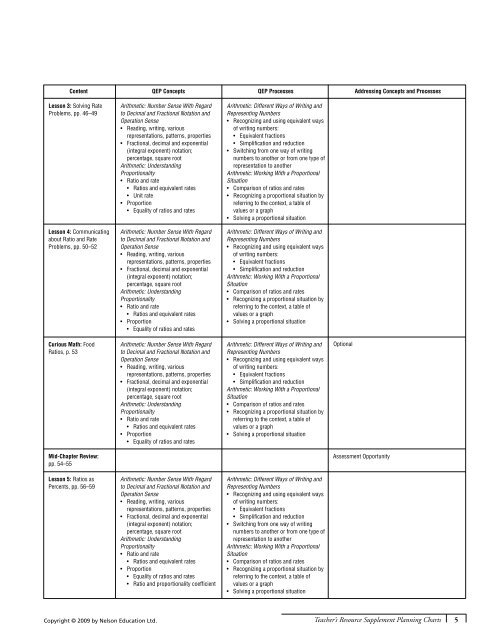Chapter 2: Ratio, Rate, and Percent - Nelson Education
Chapter 2: Ratio, Rate, and Percent - Nelson Education
Chapter 2: Ratio, Rate, and Percent - Nelson Education
You also want an ePaper? Increase the reach of your titles
YUMPU automatically turns print PDFs into web optimized ePapers that Google loves.
Content QEP Concepts QEP Processes Addressing Concepts <strong>and</strong> ProcessesLesson 3: Solving <strong>Rate</strong>Problems, pp. 46–49Arithmetic: Number Sense With Regardto Decimal <strong>and</strong> Fractional Notation <strong>and</strong>Operation Sense• Reading, writing, variousrepresentations, patterns, properties• Fractional, decimal <strong>and</strong> exponential(integral exponent) notation;percentage, square rootArithmetic: Underst<strong>and</strong>ingProportionality• <strong>Ratio</strong> <strong>and</strong> rate• <strong>Ratio</strong>s <strong>and</strong> equivalent rates• Unit rate• Proportion• Equality of ratios <strong>and</strong> ratesArithmetic: Different Ways of Writing <strong>and</strong>Representing Numbers• Recognizing <strong>and</strong> using equivalent waysof writing numbers:• Equivalent fractions• Simplification <strong>and</strong> reduction• Switching from one way of writingnumbers to another or from one type ofrepresentation to anotherArithmetic: Working With a ProportionalSituation• Comparison of ratios <strong>and</strong> rates• Recognizing a proportional situation byreferring to the context, a table ofvalues or a graph• Solving a proportional situationLesson 4: Communicatingabout <strong>Ratio</strong> <strong>and</strong> <strong>Rate</strong>Problems, pp. 50–52Arithmetic: Number Sense With Regardto Decimal <strong>and</strong> Fractional Notation <strong>and</strong>Operation Sense• Reading, writing, variousrepresentations, patterns, properties• Fractional, decimal <strong>and</strong> exponential(integral exponent) notation;percentage, square rootArithmetic: Underst<strong>and</strong>ingProportionality• <strong>Ratio</strong> <strong>and</strong> rate• <strong>Ratio</strong>s <strong>and</strong> equivalent rates• Proportion• Equality of ratios <strong>and</strong> ratesArithmetic: Different Ways of Writing <strong>and</strong>Representing Numbers• Recognizing <strong>and</strong> using equivalent waysof writing numbers:• Equivalent fractions• Simplification <strong>and</strong> reductionArithmetic: Working With a ProportionalSituation• Comparison of ratios <strong>and</strong> rates• Recognizing a proportional situation byreferring to the context, a table ofvalues or a graph• Solving a proportional situationCurious Math: Food<strong>Ratio</strong>s, p. 53Arithmetic: Number Sense With Regardto Decimal <strong>and</strong> Fractional Notation <strong>and</strong>Operation Sense• Reading, writing, variousrepresentations, patterns, properties• Fractional, decimal <strong>and</strong> exponential(integral exponent) notation;percentage, square rootArithmetic: Underst<strong>and</strong>ingProportionality• <strong>Ratio</strong> <strong>and</strong> rate• <strong>Ratio</strong>s <strong>and</strong> equivalent rates• Proportion• Equality of ratios <strong>and</strong> ratesArithmetic: Different Ways of Writing <strong>and</strong>Representing Numbers• Recognizing <strong>and</strong> using equivalent waysof writing numbers:• Equivalent fractions• Simplification <strong>and</strong> reductionArithmetic: Working With a ProportionalSituation• Comparison of ratios <strong>and</strong> rates• Recognizing a proportional situation byreferring to the context, a table ofvalues or a graph• Solving a proportional situationOptionalMid-<strong>Chapter</strong> Review:pp. 54–55Assessment OpportunityLesson 5: <strong>Ratio</strong>s as<strong>Percent</strong>s, pp. 56–59Arithmetic: Number Sense With Regardto Decimal <strong>and</strong> Fractional Notation <strong>and</strong>Operation Sense• Reading, writing, variousrepresentations, patterns, properties• Fractional, decimal <strong>and</strong> exponential(integral exponent) notation;percentage, square rootArithmetic: Underst<strong>and</strong>ingProportionality• <strong>Ratio</strong> <strong>and</strong> rate• <strong>Ratio</strong>s <strong>and</strong> equivalent rates• Proportion• Equality of ratios <strong>and</strong> rates• <strong>Ratio</strong> <strong>and</strong> proportionality coefficientArithmetic: Different Ways of Writing <strong>and</strong>Representing Numbers• Recognizing <strong>and</strong> using equivalent waysof writing numbers:• Equivalent fractions• Simplification <strong>and</strong> reduction• Switching from one way of writingnumbers to another or from one type ofrepresentation to anotherArithmetic: Working With a ProportionalSituation• Comparison of ratios <strong>and</strong> rates• Recognizing a proportional situation byreferring to the context, a table ofvalues or a graph• Solving a proportional situationCopyright © 2009 by <strong>Nelson</strong> <strong>Education</strong> Ltd.Teacher’s Resource Supplement Planning Charts5
















